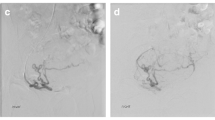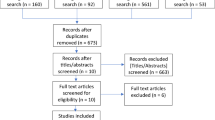Abstract
Purpose
To compare acute pain after uterine artery embolization (UAE) with tris-acryl gelatin microspheres (TAGM) versus gelatin sponge particles (GS) for leiomyoma.
Materials and Methods
This was a single-institution, retrospective study. Between July 2008 and November 2016, 101 consecutive patients with symptomatic uterine leiomyoma underwent UAE with the same protocol for post-procedural pain. GS was employed with near-stasis endpoint for the first 49 patients, whereas TAGM was used with limited endpoint for the next 52 patients. Post-UAE pain levels were compared between both groups with a linear mixed model using visual analog scale (VAS) scores from 0 to 18 h as a repeat measure outcome. Peak VAS < 24 h or dose of drugs for analgesia and conscious sedation was compared by analysis of variance. Tumor infarction was assessed with post-procedural contrast-enhanced MRI.
Results
Baseline demographics and most outcomes including tumor infarction were similar between both groups. The average VAS scores during the period <24 h were significantly lower in TAGM group (1.68, 95% CI 1.23–2.13) compared to GS group (3.28, 95% CI 2.82–3.74, p < 0.0001). The difference remained significant even after adjustment for other factors (p < 0.0001). The mean peak VAS < 24 h was also lower in TAGM group (3.89, 95% CI 3.25–4.53) than in GS group (5.90, 95% CI 5.20–6.53, p < 0.0001). The dose of drugs for analgesia and conscious sedation was significantly lower in TAGM group (p = 0.001, p = 0.004, respectively).
Conclusion
TAGM had an advantage over GS in UAE for leiomyoma in terms of less post-procedural pain <24 h, with lower doses of drugs for analgesia and conscious sedation.

Similar content being viewed by others
References
Spies JB. Recovery after uterine artery embolization: understanding and managing short-term outcomes. J Vasc Interv Radiol. 2003;14:1219–22.
Bruno J, Sterbis K, Flick P, et al. Recovery after uterine artery embolization for leiomyomas: a detailed analysis of its duration and severity. J Vasc Interv Radiol. 2004;15:801–7.
Hehenkamp WJ, Volkers NA, Birnie E, Reekers JA, Ankum WM. Pain and return to daily activities after uterine artery embolization and hysterectomy in the treatment of symptomatic uterine fibroids: results from the randomized EMMY trial. Cardiovasc Interv Radiol. 2006;29:179–87.
Lipszyc M, Winters E, Engelman E, Baurain M, Barvais L. Remifentanil patient-controlled analgesia effect-site target-controlled infusion compared with morphine patient-controlled analgesia for treatment of acute pain after uterine artery embolization. Br J Anaesth. 2011;106(5):724–31.
Kim HS, Czuczman GJ, Nicholson WK, Pham LD, Richman JM. Pain levels within 24 h after UFE: a comparison of morphine and fentanyl patient-controlled analgesia. Cardiovasc Interv Radiol. 2008;31:1100–7.
Zhan S, Li Y, Wang G, Han H, Yang Z. Effectiveness of intra-arterial anesthesia for uterine fibroid embolization using dilute lidocaine. Eur Radiol. 2005;15:1752–6.
van der Kooij SM, Moolenaar LM, Ankum WM, Reekers JA, Mol BW, Hehenkamp WJ. Epidural analgesia versus patient-controlled analgesia for pain relief in uterine artery embolization for uterine fibroids: a decision analysis. Cardiovasc Interv Radiol. 2013;36(6):1514–20.
Rasuli P, Jolly EE, Hammond I, et al. Superior hypogastric nerve block for pain control in outpatient uterine artery embolization. J Vasc Interv Radiol. 2004;15:1423–9.
Noel-Lamy M, Tan KT, Simons ME, Sniderman KW, Mironov O, Rajan DK. Intraarterial lidocaine for pain control in uterine artery embolization: a prospective, randomized study. J Vasc Interv Radiol. 2017;28(1):16–22.
Ryu RK, Omary RA, Sichlau MJ, et al. Comparison of pain after uterine artery embolization using tris-acryl gelatin microspheres versus polyvinyl alcohol particles. Cardiovasc Interv Radiol. 2003;26:375–8.
Spies JB, Allison S, Flick P, et al. Polyvinyl alcohol particles and tris-acryl gelatin microspheres for uterine artery embolization for leiomyomas: results of a randomized comparative study. J Vasc Interv Radiol. 2004;15:793–800.
Spies JB, Allison S, Flick P, et al. Spherical polyvinyl alcohol versus tris-acryl gelatin microspheres for uterine artery embolization for leiomyomas: results of a limited randomized comparative study. J Vasc Interv Radiol. 2005;16:1431–7.
Jiang W, Shen Z, Luo H, Hu X, Zhu X. Comparison of polyvinyl alcohol and tris-acryl gelatin microsphere materials in embolization for symptomatic leiomyomas: a systematic review. Minim Invasive Ther Allied Technol. 2016;25(6):289–300.
Vilos AG, Vilos GA, Hollett-Caines J, Garvin G, Kozak R, Abu-Rafea B. Post-uterine artery embolization pain and clinical outcomes for symptomatic myomas using gelfoam pledgets alone versus embospheres plus gelfoam pledgets: a comparative pilot study. J Obstet Gynaecol Can. 2014;36(11):983–9.
Shlansky-Goldberg RD, Rosen MA, Mondschein JI, et al. Comparison of polyvinyl alcohol microspheres and tris-acryl gelatin microspheres for uterine fibroid embolization: results of a single-center randomized study. J Vasc Interv Radiol. 2014;25:823–32.
Spies JB, Benenati JF, Worthington-Kirsch RL, et al. Initial experience with use of tris-acryl gelatin microspheres for uterine artery embolization for leiomyomata. J Vasc Interv Radiol. 2001;12:1059–63.
Pelage JP, Le Dref O, Beregi JP, et al. Limited uterine artery embolization with tris-acryl gelatin microspheres for uterine fibroids. J Vasc Interv Radiol. 2003;14:15–20.
Spies JB, Cornell C, Worthington-Kirsch R, Lipman JC, Benenati JF. Long-term outcome from uterine fibroid embolization with tris-acryl gelatin microspheres: results of a multicenter study. J Vasc Interv Radiol. 2007;18(2):203–7.
Katsumori T, Nakajima K, Mihara T, et al. Uterine artery embolization using gelatin sponge particles alone for symptomatic uterine fibroids: midterm results. AJR Am J Roentgenol. 2002;178:135–9.
Sone M, Arai Y, Shimizu T, et al. Phase I/II multi-institutional study of uterine artery embolization with gelatin sponge for symptomatic uterine leiomyomata: Japan interventional radiology in oncology study group study. J Vasc Interv Radiol. 2010;21:1665–71.
Katsumori T, Kasahara T, Oda M, Kotani T, et al. Initial experience of uterine fibroid embolization using porous gelatin sponge particles. Cardiovasc Interv Radiol. 2011;34:513–21.
Izumi Y, Ikeda S, Kitagawa A, et al. Uterine artery embolization by use of porous gelatin particles for symptomatic uterine leiomyomas: comparison with hand-cut gelatin sponge particles. Jpn J Radiol. 2015;33(8):461–70.
Katsumori T, Miura H, Arima H, et al. Tris-acryl gelatin microspheres versus gelatin sponge particles in uterine artery embolization for leiomyoma. Acta Radiol. 2016. doi:10.1177/0284185116674499.
Spies JB, Coyne K, Guaou Guaou N, et al. The UFS-QOL, a new disease-specific symptom and health-related quality of life questionnaire for leiomyomata. Obstet Gynecol. 2002;99:290–300.
Hovsepian DM, Siskin GP, Bonn J, CIRSE committee, SIR standards of practice committee, et al. Quality improvement guidelines for uterine artery embolization for symptomatic leiomyomata. J Vasc Interv Radiol. 2004;15:535–41.
Ruuskanen A, Sipola P, Hippeläinen M, Wüstefeld M, Manninen H. Pain after uterine fibroid embolization is associated with the severity of myometrial ischaemia on magnetic resonance imaging. Eur Radiol. 2009;19:2977–85.
Osuga K, Anai H, Takahashi M, et al. Porous gelatin particles for hepatic arterial embolization; investigation of the size and fragmentation before and after microcatheter passage. Jpn J Cancer Chemother. 2009;36:437–42.
Spies JB. What evidence should we demand before accepting a new embolic material for uterine artery embolization? J Vasc Interv Radiol. 2009;20:567–70.
Author information
Authors and Affiliations
Corresponding author
Ethics declarations
Conflict of interest
Tetsuya Katsumori has received payment for lectures and writing articles from Nippon Kayaku. The payments are not related to the present manuscript. The other authors have no conflict of interest.
Informed Consent
Informed consent was obtained from all individual participants included in the study.
Ethical Approval
All procedures performed in studies involving human participants were in accordance with the ethical standards of the institutional and/or national research committee and with the 1964 Helsinki Declaration and its later amendments or comparable ethical standards. For this type of study, formal consent is not required.
Rights and permissions
About this article
Cite this article
Katsumori, T., Arima, H., Asai, S. et al. Comparison of Pain Within 24 h after Uterine Artery Embolization with Tris-Acryl Gelatin Microspheres Versus Gelatin Sponge Particles for Leiomyoma. Cardiovasc Intervent Radiol 40, 1687–1693 (2017). https://doi.org/10.1007/s00270-017-1691-4
Received:
Accepted:
Published:
Issue Date:
DOI: https://doi.org/10.1007/s00270-017-1691-4




